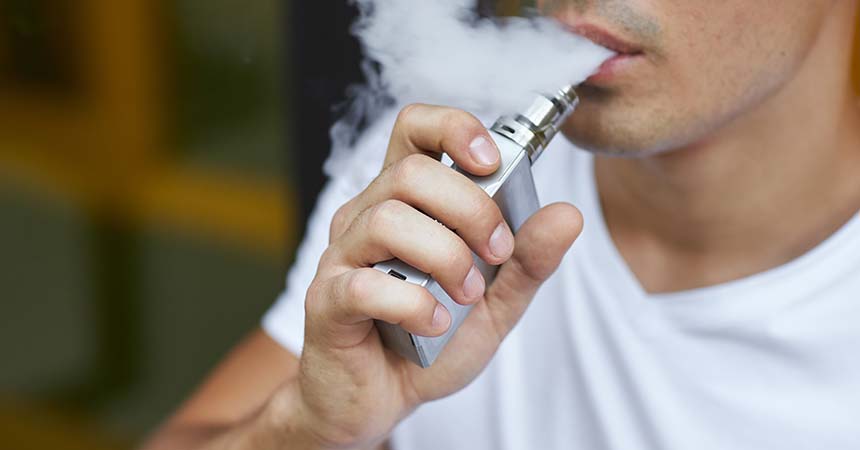Vapers may be at higher risk for COVID-19
Attention vapers — new evidence links vaping to a higher risk of getting COVID-19.
The risk has been shown to be 5 to 7 times higher, according to new scientific research, prompting lawmakers around the country to urge the FDA to temporarily clear the market of all e-cigarettes during the COVID pandemic.
This increased health threat is especially troubling for teens and young adults, considering that the CDC reports nearly one-third of all American high school students used e-cigarettes in 2019.
Why is COVID more dangerous for those who vape?
“There are a number of reasons why vaping leaves users more susceptible,” said HSC faculty researcher Dr. Tracey Barnett, Associate Dean for Academic Affairs at the HSC School of Public Health. Dr. Barnett focuses her work and community outreach on this important public health concern.
“Vaping has been shown to irritate the lungs, leaving users more vulnerable to illness, including flu, asthma and pneumonia. Inhaling e-cigarette products also requires deeper breathing and taking in more air,” Dr. Barnett said. “This is not the scenario you want during the COVID pandemic.”
“Young people are more apt to share e-cigarettes in close social settings, while hanging out, which doesn’t lend itself well to social distancing. Vaping also involves a lot of touching to the face and mouth, which could increase the possibility for infection. Overall, it’s a dangerous situation for spread of the virus.”
Vaping has been associated with lung inflammation, as has COVID-19. Both lead to irritation of the lungs’ protective lining.
“Both of those conditions together do a real number on the lungs, producing a double whammy effect,” Dr. Barnett said.
A recently published study in the Journal of Adolescent Health looked at more than 4,300 survey participants of ages 13-24 from all 50 states, who either had or had not used e-cigarettes in the previous month. The study took into account respondents’ self-reported compliance with shelter-in-place orders and the rates of COVID-19 in their states, as well as age, sex, race/ethnicity, body mass index and socioeconomic status. The researchers noted that sheltering in place may mean different things to different people, and that young adults responding to the survey may have considered sharing a smoke with friends in the backyard to be safe.
Overall, the research found that e-cigarette users were almost 5 times more likely to have had COVID-19 symptoms, testing and a positive diagnosis.
Dual users of both traditional and e-cigarettes were 6.8 times more likely to be diagnosed with COVID. Both smoking and vaping are known to damage the lungs and impact the immune system.
“This is a significant finding, in that adolescents and young adults are more apt to be dual users of both types of cigarettes,” Dr. Barnett said, “putting them at an even higher risk for COVID-19. It’s not a small risk, it’s an important one.”
“Young people who see vaping as the cool thing to do may not fully comprehend the health risks,” Dr. Barnett said. “They also might feel invincible because of their age, or ignore the public health warnings about COVID. Put these two factors together, and the combination presents a real recipe for concern.”
According to the Partnership to End Addiction, teens and young adults say they vape for a variety of reasons, including curiosity, peer pressure, appealing flavors and because they have seen others do it. Some also say they do it because they feel it is less harmful than other tobacco products and it’s also discreet.
It is now widely recognized that vaping is unhealthy and dangerous, with adverse health effects including coughing, wheezing, inflammation and potential severe lung injury. The lungs have to work harder, placing more stress on the body’s other organs.
Nearly all vapes contain nicotine, one of the most addictive substances, and in many cases as much as or more than in traditional cigarettes. Nicotine negatively impacts the cardiovascular system and respiratory/lung functioning.
Vape flavoring ingredients can also be harmful – many have been determined to contain cancer-causing and other toxic chemicals, heavy metals and tiny particles that go deep into the lungs, damaging lungs and cells and reducing the ability to fight off infections.
“A weakened immune system or damage to the lungs from vaping could produce a more serious case of COVID-19, with the body unable to keep up,” Dr. Barnett said.
This new research presents a wakeup call and a warning to young people, Dr. Barnett said, as well as parents and health providers, who can be instrumental in talking to kids about their health, especially during the pandemic.
“Far too many young people have suffered the effects of vaping, and now with the added threat of COVID-19 in communities across the country, it’s important to protect ourselves and stay as healthy as we can,” she said. “I hope this message resonates with young people and their families.”






Social media